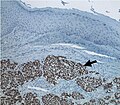Merkel cell carcinoma
Jump to navigation
Jump to search
The printable version is no longer supported and may have rendering errors. Please update your browser bookmarks and please use the default browser print function instead.
| Merkel cell carcinoma | |
|---|---|
| Diagnosis in short | |
 Merkel cell carcinoma. H&E stain. | |
|
| |
| LM | neuroendocrine nuclear features (round nucleus, small nucleoli/no nucleolus, stippled chromatin), usually scant cytoplasm, usually small (~3x resting lymphocyte), often in sheets |
| LM DDx | small cell carcinoma, cutaneous Ewing sarcoma, Burkitt lymphoma, other small round blue cell tumours |
| IHC | Merkel cell polyomavirus +ve, CK20 +ve (perinuclear dot-like), CD56 +ve, TTF-1 -ve, CK7 -ve, NF +ve |
| Site | skin |
|
| |
| Clinical history | +/-immunosuppressed/immunoincompetent |
| Prevalence | rare |
| Prognosis | poor |
| Merkel cell carcinoma | |
|---|---|
| External resources | |
| Wikipedia | merkel cell carcinoma |
Merkel cell carcinoma, abbreviated MCC, is an uncommon aggressive form of skin cancer.
General
Features:[1]
- Rare.
- Aggressive course/poor prognosis.
- Neuroendocrine-like.[2]
Etiology:
- Most caused by Merkel cell polyomavirus.[3][1]
- Immunocompromised/immunosuppressed (e.g. organ transplant recipients).
Microscopic
Features:[4]
- Neuroendocrine nuclear features - round nucleus, small nucleoli/no nucleolus, stippled chromatin - key feature.
- Typically medium size cells ~3x resting lymphocyte.
- May be small or large.
- Architecture: nests, sheets or trabeculae.
- Scant cytoplasm.
- Abundant mitoses. †
- +/-Nuclear moulding.
- Nuclei of adjacent cells conform to one another.
- +/-Tumour infiltrating lymphocytes. ‡
Notes:
- † >10 mitoses/HPF = poor prognosis - definition suffers from HPFitis.[5]
- ‡ May be associated with a worse prognosis.[5]
- Merkel cell carcinoma lymph node metastases is difficult to diagnose with routine stains; use of IHC stains are advised.[5]
- Arise from the epidermis - very rarely in situ.[6]
DDx:
- Basal cell carcinoma - no stippled chromatin, less mitoses active.
- Cutaneous Ewing sarcoma - sorted-out with immunostains.
- Lymphoma.
- Metastatic small cell carcinoma.
- Other small round cell tumours.
Images
www:
- MCC (bccancer.bc.ca).
- MCC (joplink.net).
- Merkel cell carcinoma (ispub.com).
- Merkel cell carcinoma - several images (upmc.edu).
IHC
Features:
- CK7 -ve.
- CK20 +ve (perinuclear dot-like).[7]
- CAM5.2 +ve (dot-like pattern).
- CD56 +ve.
- AE1/AE3 +ve.
- Merkel cell polyomavirus +ve ~85% of cases.[8]
- NF +ve (12 of 13 cases).[9]
- Useful to differentiate from small cell carcinoma of lung.
Others:
EM
- Neurosecretory granules (AKA dense-core granules).[12]
See also
References
- ↑ 1.0 1.1 Calder, KB.; Smoller, BR. (May 2010). "New insights into merkel cell carcinoma.". Adv Anat Pathol 17 (3): 155-61. doi:10.1097/PAP.0b013e3181d97836. PMID 20418670.
- ↑ Pulitzer, MP.; Amin, BD.; Busam, KJ. (May 2009). "Merkel cell carcinoma: review.". Adv Anat Pathol 16 (3): 135-44. doi:10.1097/PAP.0b013e3181a12f5a. PMID 19395876.
- ↑ Feng, H.; Shuda, M.; Chang, Y.; Moore, PS. (Feb 2008). "Clonal integration of a polyomavirus in human Merkel cell carcinoma.". Science 319 (5866): 1096-100. doi:10.1126/science.1152586. PMID 18202256.
- ↑ Humphrey, Peter A; Dehner, Louis P; Pfeifer, John D (2008). The Washington Manual of Surgical Pathology (1st ed.). Lippincott Williams & Wilkins. pp. 491. ISBN 978-0781765275.
- ↑ 5.0 5.1 5.2 URL: /2011/SkinMerkelCell_11protocol.pdf http://www.cap.org/apps/docs/committees/cancer/cancer_protocols/2011/SkinMerkelCell_11protocol.pdf. Accessed on: 28 March 2012.
- ↑ 6.0 6.1 Ferringer, T.; Rogers, HC.; Metcalf, JS. (Feb 2005). "Merkel cell carcinoma in situ.". J Cutan Pathol 32 (2): 162-5. doi:10.1111/j.0303-6987.2005.00270.x. PMID 15606676.
- ↑ Leech, SN.; Kolar, AJ.; Barrett, PD.; Sinclair, SA.; Leonard, N. (Sep 2001). "Merkel cell carcinoma can be distinguished from metastatic small cell carcinoma using antibodies to cytokeratin 20 and thyroid transcription factor 1.". J Clin Pathol 54 (9): 727-9. PMID 11533085.
- ↑ Jung, HS.; Choi, YL.; Choi, JS.; Roh, JH.; Pyon, JK.; Woo, KJ.; Lee, EH.; Jang, KT. et al. (Oct 2011). "Detection of Merkel cell polyomavirus in Merkel cell carcinomas and small cell carcinomas by PCR and immunohistochemistry.". Histol Histopathol 26 (10): 1231-41. PMID 21870327.
- ↑ Bobos M, Hytiroglou P, Kostopoulos I, Karkavelas G, Papadimitriou CS (April 2006). "Immunohistochemical distinction between merkel cell carcinoma and small cell carcinoma of the lung". Am J Dermatopathol 28 (2): 99–104. doi:10.1097/01.dad.0000183701.67366.c7. PMID 16625069.
- ↑ Jankowski, M.; Kopinski, P.; Schwartz, R.; Czajkowski, R. (Nov 2014). "Merkel cell carcinoma: is this a true carcinoma?". Exp Dermatol 23 (11): 792-4. doi:10.1111/exd.12490. PMID 25040178.
- ↑ "Expression of anaplastic lymphoma kinase in Merkel cell carcinomas". Hum Pathol 44 (8): 1656–64. August 2013. doi:10.1016/j.humpath.2012.11.021. PMID 23574788.
- ↑ Gil-Moreno, A.; Garcia-Jiménez, A.; González-Bosquet, J.; Esteller, M.; Castellví-Vives, J.; Martínez Palones, JM.; Xercavins, J. (Mar 1997). "Merkel cell carcinoma of the vulva.". Gynecol Oncol 64 (3): 526-32. PMID 9062165.



